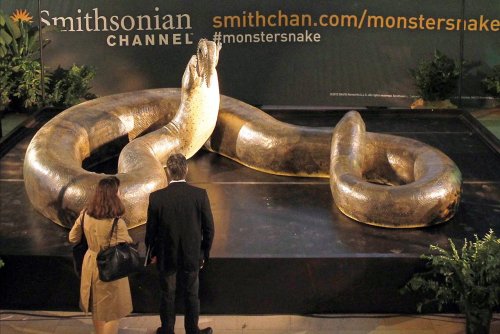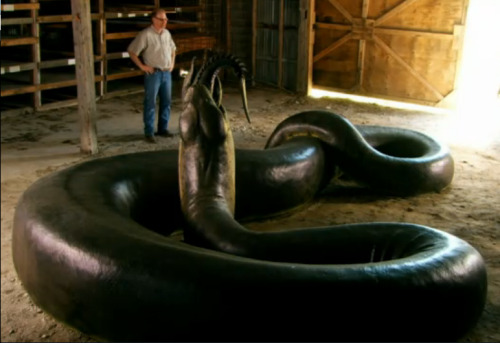ceescedasticity:mc1303:injuries-in-dust:thelogicalloganipus:shameless-running-turtle:floralprintpuss
ceescedasticity:mc1303:injuries-in-dust:thelogicalloganipus:shameless-running-turtle:floralprintpussy:lokiwtf:gallizfrey:anneriawings:siphersaysstuff:honey-andrevolution:sashayed:silvermoon424:poppypicklesticks:billybatsonandjameshowlettsbro:cosmicallycosmopolitan:billybatsonandjameshowlettsbro:james-winston:The Titanoboa, is a 48ft long snake dating from around 60-58million years ago. It had a rib cage 2ft wide, allowing it to eat whole crocodiles, and surrounding the ribcage were muscles so powerful that it could crush a rhino. Titanoboa was so big it couldn’t even spend long amounts of time on land, because the force of gravity acting on it would cause it to suffocate under its own weight.I’m so glad they aren’t aroundomg me too. I’m scared enough of 26 ft long anacondas. I’m so happy Megalodons, those giant sharks, aren’t alive eitherPraise natural selectionI remember watching Walking with Beasts or something similar, or some British tv show about evolutionThe subject was something like a 12 foot long water scorpionI was so startled by its sudden appearance and narration that I yelped: “12 fucking feet?!?! I’m fucking glad it’s extinct!” Dude, prehistory was home to some fucking TERRIFYING creatures. For some reason, everything back then was enormous and scary. Extinction doesn’t always have to be a bad thing!And Poppy, what you saw was an arthropod known as Pterygotus (it was actually featured in Walking With Monsters). Not only was it as big (or maybe even bigger) than your average human, it had a stinger the size of a lightbulb. REALLY glad that bugger isn’t around anymore.Also, Megalodon deserves to be mention again, because just hearing its name makes me want to never be submerged in water ever again.GOD, I HATE THIS POST. HOW DO WE EVEN KNOW THAT SHIT ISN’T STILL AROUND? LURKING? EVOLVING? WE DON’T. WE DON’T KNOW SHIT ABOUT SHIT DOWN THERE. THE OCEAN IS A PRIMEVAL HELLSCAPE NIGHTMARE AND WE ALL JUST DIP OUR STUPID FRAGILE UNPROTECTED FETUS BODIES AROUND THE EDGES OF IT LIKE THAT’S NORMAL. FUCK THE OCEAN.this is so relevant to my interests It wasn’t just the predators. North Carolina was once home to giant ground sloths…THAT IS A GODDAMNED LEAF-EATING SLOTH.We’ve got a skeleton of one of these fuckers at the museum downtown, and man, just being NEAR it is unsettling.DON’T FORGET PREHISTORIC WHALES, SOME OF THOSE FUCKERS WERE TERRIFYINGAMBULOCETUS WAS AMPHIBIOUS AND PRETTY BADASSBASILOSAURUS WAS THIS GIANT REPTILIAN CETACEAN THAT PROBABLY SWAM LIKE A DUMB EEL BECAUSE OF ITS TINY FLUKES BUT THIS FUCKER WAS 60 FEET LONG AND AT THE TOP OF THE MARINE FOOD CHAINAND THEN THERE’S MY FAVORITE, ZYGOPHYSETER, WHICH WAS THIS HUGE EARLY SPERM WHALE THAT ATE SHARKS AND OTHER WHALESIT WAS NOTHING BUT TEETHThe reason why the animals in the prehistoric times were so big was because there was much more oxygen in the atmosphere if I recall correctly. Because there was so much oxygen and so few carbon gasses, life on earth was able to grow to terrifying lengths and heights, don’t forget how giant the bugs were.I have never seen so much prime nope in a single postAlso important to note that megalodon is theorized to still be alive,possibly living in the darkest depths of the ocean. They haven’t found signs of its extinctionscientists: “we haven’t seen a megalodon in quite some time now, let’s just hope it’s exstinct”This whole post is my JAM not gonna lie I am fascinated by massive prehistoric animalsWho else wants to stick a saddle on the beetle and ride it across the land?*raises hand*But also, plants were so abundant in that time that the oxygen levels rose to staggering degrees, which allowed the massive growth of the various species, but then the ecosystems they partook in couldn’t sustain the size of their bodies with the amount of food they needed and over time they simply started to die out. Fear the giants of the past.Ride the beatles1. There is another post around somewhere which points out that we ARE very confident Megalodon is extinct, because if it weren’t extinct it’d be preying on the large whales that only got so large and unmanueverable after Megalodon wasn’t around to eat them.2. I think the “higher oxygen” thing is specifically relevant to the giant invertebrates we got waaaaaay back pre-dinosaurs. I don’t think it was much of a factor with the dinosaurs, still less mammals. I’m not sure about that, though, just sure it was important for the invertebrates. 3. I dont think I’ve seen anything about animals getting too big for their ecosystems to sustain them? I think evolution of size change is too slow for that. It’s population booms that get you in trouble. –Unless you mean that the oxygen levels went down because more animals were using oxygen? I think that’s true. Still not a size problem though. -- source link
Tumblr Blog : james-winston.tumblr.com

